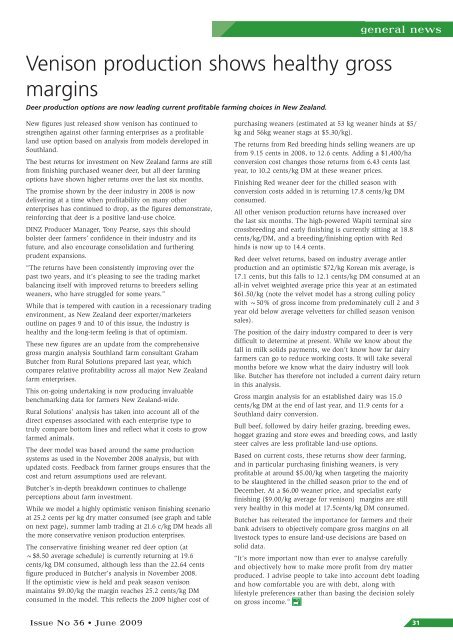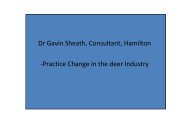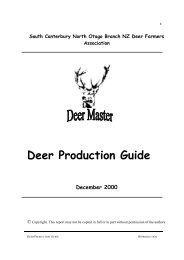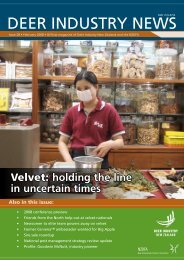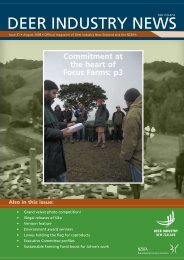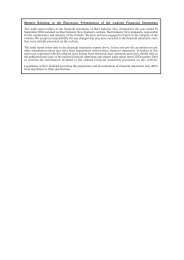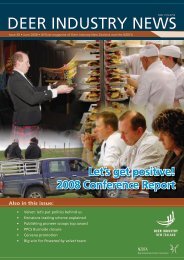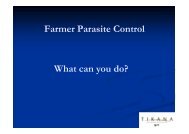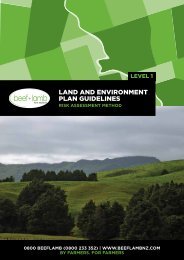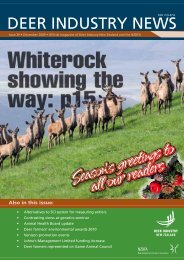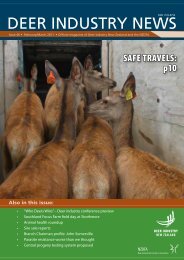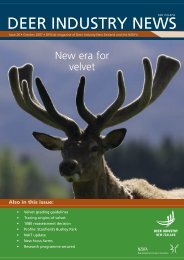Deer Industry News #36 June 2009 - Deer Industry New Zealand
Deer Industry News #36 June 2009 - Deer Industry New Zealand
Deer Industry News #36 June 2009 - Deer Industry New Zealand
- No tags were found...
Create successful ePaper yourself
Turn your PDF publications into a flip-book with our unique Google optimized e-Paper software.
Venison production shows healthy grossmargins<strong>Deer</strong> production options are now leading current profitable farming choices in <strong>New</strong> <strong>Zealand</strong>.general news<strong>New</strong> figures just released show venison has continued tostrengthen against other farming enterprises as a profitableland use option based on analysis from models developed inSouthland.The best returns for investment on <strong>New</strong> <strong>Zealand</strong> farms are stillfrom finishing purchased weaner deer, but all deer farmingoptions have shown higher returns over the last six months.The promise shown by the deer industry in 2008 is nowdelivering at a time when profitability on many otherenterprises has continued to drop, as the figures demonstrate,reinforcing that deer is a positive land-use choice.DINZ Producer Manager, Tony Pearse, says this shouldbolster deer farmers’ confidence in their industry and itsfuture, and also encourage consolidation and furtheringprudent expansions.“The returns have been consistently improving over thepast two years, and it’s pleasing to see the trading marketbalancing itself with improved returns to breeders sellingweaners, who have struggled for some years.”While that is tempered with caution in a recessionary tradingenvironment, as <strong>New</strong> <strong>Zealand</strong> deer exporter/marketersoutline on pages 9 and 10 of this issue, the industry ishealthy and the long-term feeling is that of optimism.These new figures are an update from the comprehensivegross margin analysis Southland farm consultant GrahamButcher from Rural Solutions prepared last year, whichcompares relative profitability across all major <strong>New</strong> <strong>Zealand</strong>farm enterprises.This on-going undertaking is now producing invaluablebenchmarking data for farmers <strong>New</strong> <strong>Zealand</strong>-wide.Rural Solutions’ analysis has taken into account all of thedirect expenses associated with each enterprise type totruly compare bottom lines and reflect what it costs to growfarmed animals.The deer model was based around the same productionsystems as used in the November 2008 analysis, but withupdated costs. Feedback from farmer groups ensures that thecost and return assumptions used are relevant.Butcher’s in-depth breakdown continues to challengeperceptions about farm investment.While we model a highly optimistic venison finishing scenarioat 25.2 cents per kg dry matter consumed (see graph and tableon next page), summer lamb trading at 21.6 c/kg DM heads allthe more conservative venison production enterprises.The conservative finishing weaner red deer option (at~$8.50 average schedule) is currently returning at 19.6cents/kg DM consumed, although less than the 22.64 centsfigure produced in Butcher’s analysis in November 2008.If the optimistic view is held and peak season venisonmaintains $9.00/kg the margin reaches 25.2 cents/kg DMconsumed in the model. This reflects the <strong>2009</strong> higher cost ofpurchasing weaners (estimated at 53 kg weaner hinds at $5/kg and 56kg weaner stags at $5.30/kg).The returns from Red breeding hinds selling weaners are upfrom 9.15 cents in 2008, to 12.6 cents. Adding a $1,400/haconversion cost changes those returns from 6.43 cents lastyear, to 10.2 cents/kg DM at these weaner prices.Finishing Red weaner deer for the chilled season withconversion costs added in is returning 17.8 cents/kg DMconsumed.All other venison production returns have increased overthe last six months. The high-powered Wapiti terminal sirecrossbreeding and early finishing is currently sitting at 18.8cents/kg/DM, and a breeding/finishing option with Redhinds is now up to 14.4 cents.Red deer velvet returns, based on industry average antlerproduction and an optimistic $72/kg Korean mix average, is17.1 cents, but this falls to 12.1 cents/kg DM consumed at anall-in velvet weighted average price this year at an estimated$61.50/kg (note the velvet model has a strong culling policywith ~50% of gross income from predominately cull 2 and 3year old below average velvetters for chilled season venisonsales).The position of the dairy industry compared to deer is verydifficult to determine at present. While we know about thefall in milk solids payments, we don’t know how far dairyfarmers can go to reduce working costs. It will take severalmonths before we know what the dairy industry will looklike. Butcher has therefore not included a current dairy returnin this analysis.Gross margin analysis for an established dairy was 15.0cents/kg DM at the end of last year, and 11.9 cents for aSouthland dairy conversion.Bull beef, followed by dairy heifer grazing, breeding ewes,hogget grazing and store ewes and breeding cows, and lastlysteer calves are less profitable land-use options.Based on current costs, these returns show deer farming,and in particular purchasing finishing weaners, is veryprofitable at around $5.00/kg when targeting the majorityto be slaughtered in the chilled season prior to the end ofDecember. At a $6.00 weaner price, and specialist earlyfinishing ($9.00/kg average for venison) margins are stillvery healthy in this model at 17.5cents/kg DM consumed.Butcher has reiterated the importance for farmers and theirbank advisers to objectively compare gross margins on alllivestock types to ensure land-use decisions are based onsolid data.“It’s more important now than ever to analyse carefullyand objectively how to make more profit from dry matterproduced. I advise people to take into account debt loadingand how comfortable you are with debt, along withlifestyle preferences rather than basing the decision solelyon gross income.”Issue No 36 • <strong>June</strong> <strong>2009</strong> 31


